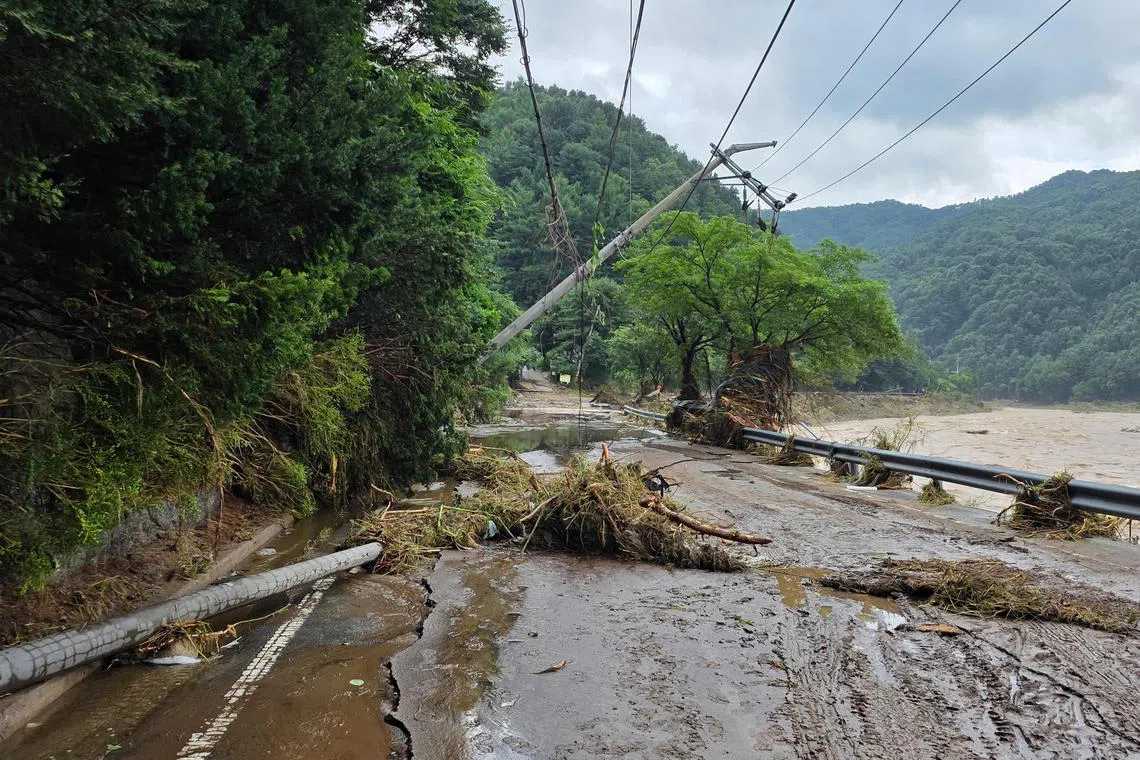South Korea goes all out in recovery efforts after days of torrential rain
Sign up now: Get insights on Asia's fast-moving developments

Damaged cars in Gapyeong, a county in the northern part of South Korea's Gyeonggi province, on July 20.
PHOTO: AFP
Follow topic:
SEOUL - As South Korea reels from days of record-breaking rain that have unleashed deadly floods and disrupted daily life across the country, the government launched sweeping recovery efforts on July 20 amid mounting casualties and ongoing rescue operations.
At least 16 people were confirmed dead
The authorities warned that the toll could rise as search-and-rescue efforts continue in flood- and landslide-stricken areas.
The Ministry of the Interior and Safety has activated a pan-governmental recovery support headquarters to ensure a seamless transition from emergency response to recovery, starting on July 20.
“President Lee Jae Myung has instructed a swift assessment of the flood damage and the prompt designation of special disaster zones,” presidential spokesperson Kang Yu-jung said.
The designation of a special disaster zone allows the government to provide partial financial aid for the restoration of both private and public facilities damaged by heavy rain. Affected residents will also receive a range of financial support, including a reduction in public utility fees and deferred local tax payments.
Earlier in the day, Interior Minister Yoon Ho-jung said during an emergency headquarters meeting that the ministry would “recommend to the President that severely affected areas be designated as special disaster zones in accordance with support criteria and procedures, to ensure comprehensive assistance can be provided”.
According to the ministry, all available personnel and resources, ranging from relevant ministries, local governments and private-sector experts, would be mobilised to restore damaged infrastructure, support evacuees and provide disaster relief supplies in affected areas.
Mr Yoon added that prompt damage assessment would be carried out to develop restoration plans for damaged facilities such as homes, commercial buildings and roads.
“The ministry and local governments need to ensure that the displaced residents, who stay in the temporary shelters, do not face any inconvenience, by providing a sufficient amount of relief supplies and making their utmost effort in emergency restoration to help evacuees return to their normal lives as quickly as possible,” said the minister.
Prime Minister Kim Min-seok dispatched Agricultural Minister Song Mi-ryung to respond to cases of severe casualties following heavy rain and landslides in Sancheong-gun, a county in the western area of South Gyeongsang province.
The Agricultural Minister was tasked with promptly implementing recovery measures against the significant loss of life and property in Sancheong-gun, according to the Prime Minister’s Office.
July 19 marked the first time in South Korea’s history that a single local government – Sancheong-gun – had ordered an evacuation of its entire jurisdiction due to heavy rain.
The district experienced the most intense rainfall of any area, with the accumulated precipitation recording 793.5mm and the rate of precipitation exceeding 100mm per hour.
The emergency evacuation order was issued for approximately 33,000 residents.
The fire authorities reported that as at 10am on July 20, eight residents had been found dead due to cases of landslides, flooded houses and vehicular incidents.
Many Sancheong-based villages experienced power outages. Amid communication disruptions and roads connecting the county to nearby cities being submerged, six people were reported missing in the downpour and landslides that began across the county on July 19.
A deadly landslide in Gapyeong was one of many incidents reported, as torrential rain also battered Gyeonggi province. At around 4.45am, four residents were reportedly buried under the landslide in the county in the northern part of the province.

A damaged road after heavy rain in Gapyeong, a county in Gyeonggi province, on July 20.
PHOTO: AFP
Fire officials rescued three residents, but they found a woman in her 70s dead in a collapsed guest house. The authorities also confirmed the death of a man in his 40s near a bridge in Daebo-ri, a village located in the central part of Gapyeong-gun.
While the exact time and location of the incidents have not been confirmed, 10 residents were reported missing and out of contact with their families.
The emergency headquarters stated that 9,694 households – comprising 13,000 residents – from a total of 90 cities, counties and districts had been temporarily evacuated by 9am on July 20.
Train services restarted operations from the morning, except for three lines that include services from Seoul to Busan, Mokpo and Gwangju.
Though additional alerts for heavy rainfall had not been issued as at 10am on July 20, the emergency headquarters announced that additional rainfall could hit the Greater Seoul region and Gangwon province. THE KOREA HERALD/ASIA NEWS NETWORK

